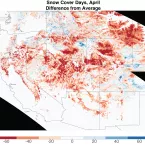The seasonal maximum extent of Arctic sea ice has passed, and with the passing of the vernal equinox, the sun has risen at the north pole. While there are plenty of cold days ahead, the long polar night is over.
Our Research
As climate changes, how do Earth's frozen areas affect our planet and impact society?
In this section
Related News & Stories
Filter by:

Analysis - Snow Today
Snow-covered area was below average in April 2021 with recent storms on the west coast pushing conditions closer to average. Snow cover days, cumulative over the season, are well below average for this water year, which spans from October 1, 2020 to present.
Analysis - Sea Ice Today
The spring decline in Arctic sea ice extent continued at varying rates through the month of April, highlighted by a mid-month pause.

News Release
The National Snow and Ice Data Center (NSIDC) announced this week their participation in the 50x30 Coalition, a group of governments and cryosphere and emissions research institutions endorsing the

Feature Story
With support from NASA, the NSIDC DAAC now offers a solution to compare years of altimeter data in the form of an interactive tool called IceFlow.

Analysis - Ice Sheets Today
With the exception of the northern and southern Antarctic Peninsula, the Antarctic melt season for 2020 to 2021 was unremarkable and below the 1990 to 2020 average.